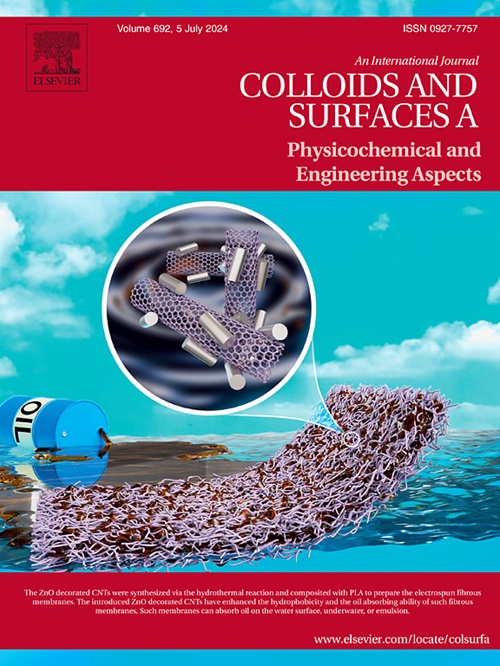Dual inhibition of GPX4 and LCN2 via miR-214–3p loaded iron oxide nanoparticles for enhancing ferroptosis in liver cancer
IF 4.9
2区 化学
Q2 CHEMISTRY, PHYSICAL
Colloids and Surfaces A: Physicochemical and Engineering Aspects
Pub Date : 2025-04-25
DOI:10.1016/j.colsurfa.2025.137049
引用次数: 0
Abstract
Liver cancer, particularly hepatocellular carcinoma (HCC), presents significant therapeutic challenges due to factors such as drug resistance and systemic toxicity. Ferroptosis, an iron-dependent form of cell death, offers a promising alternative to overcome these challenges. This study investigates the use of folic acid-modified iron oxide nanoparticles as a delivery system for miR-214–3p to promote ferroptosis in liver cancer cells. The folic acid modification enhances the efficiency of nanoparticle-mediated miR-214–3p delivery, thereby improving its therapeutic potential. miR-214–3p plays a dual role in promoting ferroptosis: first, by downregulating lipocalin-2 (LCN2), it acts synergistically with iron oxide nanoparticles to increase intracellular iron levels, reduce iron excretion, and promote the Fenton reaction; second, by inhibiting glutathione peroxidase 4 (GPX4), it weakens cellular antioxidant defenses, further promoting ferroptosis. Our in vitro experiments demonstrated that the folic acid-modified nanoparticles effectively delivered miR-214–3p, resulting in significant ferroptosis in liver cancer cells. Animal models showed that FeNP/miR could effectively target tumors and had excellent tumor suppressive effects. This research highlights a promising approach for targeting HCC through enhanced nanoparticle-based gene therapy, offering a potential strategy in cancer treatment.
负载miR-214-3p的氧化铁纳米颗粒对GPX4和LCN2的双重抑制促进肝癌中的铁上吊
肝癌,特别是肝细胞癌(HCC),由于耐药和全身毒性等因素,提出了重大的治疗挑战。铁下垂是一种依赖铁的细胞死亡形式,为克服这些挑战提供了一种有希望的替代方案。本研究探讨了使用叶酸修饰的氧化铁纳米颗粒作为miR-214-3p的递送系统促进肝癌细胞铁凋亡。叶酸修饰提高了纳米颗粒介导的miR-214-3p递送的效率,从而提高了其治疗潜力。miR-214-3p在促进铁凋亡中起双重作用:一是通过下调脂载素-2 (lipocalin-2, LCN2),与氧化铁纳米颗粒协同作用,增加细胞内铁水平,减少铁排泄,促进Fenton反应;其次,通过抑制谷胱甘肽过氧化物酶4 (GPX4),削弱细胞抗氧化防御能力,进一步促进铁下垂。我们的体外实验表明,叶酸修饰的纳米颗粒有效地递送miR-214-3p,导致肝癌细胞明显的铁凋亡。动物模型表明,FeNP/miR能有效靶向肿瘤,具有良好的抑瘤作用。本研究强调了一种通过增强纳米颗粒基因治疗靶向HCC的有希望的方法,为癌症治疗提供了一种潜在的策略。
本文章由计算机程序翻译,如有差异,请以英文原文为准。
求助全文
约1分钟内获得全文
求助全文
来源期刊
CiteScore
8.70
自引率
9.60%
发文量
2421
审稿时长
56 days
期刊介绍:
Colloids and Surfaces A: Physicochemical and Engineering Aspects is an international journal devoted to the science underlying applications of colloids and interfacial phenomena.
The journal aims at publishing high quality research papers featuring new materials or new insights into the role of colloid and interface science in (for example) food, energy, minerals processing, pharmaceuticals or the environment.

 求助内容:
求助内容: 应助结果提醒方式:
应助结果提醒方式:


